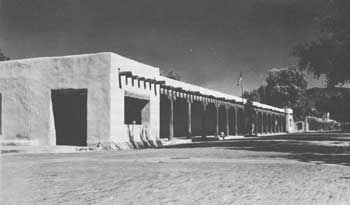






Survey of Historic Sites and Buildings
 |
PALACE OF THE GOVERNORS New Mexico |
 |
| ||
Ownership and Administration. State of New Mexico; Museum of New Mexico.
Significance. The Palace of the Governors, also known as the "Adobe Palace," is the oldest public building in the United States. It embodies much of the heritage and spirit of the historic Spanish capital of New Mexico, Santa Fe. Built about 1610, it has served as the Spanish, Mexican, and American capitols of New Mexico and the residence of its Governors. Even during the period 1680-92, when the Spaniards were ejected by the Indians from New Mexico, it apparently served as the residence and headquarters of the leaders of the Pueblo Revolt.
Don Pedro de Peralta, second royal Governor of New Mexico, had the palace constructed as part of the royal presidio of Sante Fe. The palace housed administrative offices and living quarters of the Spanish Governors until the Indian rebellion of 1680. When the Spanish defenders abandoned the palace and broke through the Indian lines to make their escape to the south, Santa Fe fell. The Indians held it for a dozen years until Don Diego de Vargas subjugated them once again, in 1692. The palace again became the seat of Spanish authority in New Mexico and continued to be so throughout the 18th and early 19th centuries.
Mexican Governors replaced the Spanish after the successful Mexican revolution in 1821, and resided in the building until Gen. Stephen Watts Kearny's "Army of the West" occupied Santa Fe and raised the U.S. flag in 1846. From then until 1885, except for a brief Confederate occupation during the Civil War, the palace housed the American Territorial government of New Mexico. A new State capitol building was occupied for offices and legislative uses in 1885, but until 1909 the Governors continued to use the palace as their residence.
 |
| Palace of the Governors, in Santa Fe, is the oldest public building in the United States. Built about 1610, for nearly three centuries it served as capitol of New Mexico and as the residence of Spanish, Mexican, and American Governors. (Courtesy, New Mexico State Tourist Bureau.) |
Present Appearance. For more than 350 years, the palace has evolved through cycles of damage, repair, reconstruction, modification, and restoration. The present structure occupies the original site. Despite modern reconstruction and restoration, much of it is the original building. It occupies the entire northern side of the historic plaza of Santa Fe—end of the Santa Fe Trail and site of romance and adventure in the minds of generations of Americans who have been enthralled with the stories about Kit Carson and others associated with the American development of the Southwestern United States.
The front of the building is a block-long portal. Behind the palace is a large and attractive patio, fully enclosed by connecting parts of the building and walls. The pueblo architectural style—plastered adobe, flat roof, viga ceiling—is typical of the 17th century, when the palace, as an integral part of the presidio, covered and enclosed about 2 acres. Operated by the Museum of New Mexico, the palace houses an excellent display of exhibits relating to the prehistoric, Spanish, and Territorial periods of New Mexico history. [44]
NHL Designation: 10/09/60
 |
 |
http://www.cr.nps.gov/history/online_books/explorers-settlers/sitec39.htm
Last Updated: 22-Mar-2005